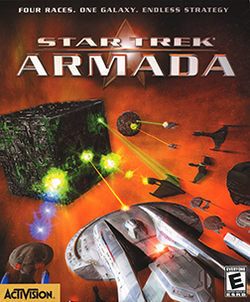Star Trek: Armada
| Star Trek: Armada | |
|---|---|
 |
|
| Developer(s) | Activision |
| Publisher(s) | Activision |
| Director(s) | Trey Watkins |
| Designer(s) | Eric Gewirtz |
| Engine | Storm3D |
| Platform(s) | Microsoft Windows |
| Release |
|
| Genre(s) | Real-time strategy |
| Mode(s) | Single-player, multiplayer |
Star Trek: Armada is a real-time strategy video game developed and published in 2000 by Activision. The game's look and feel is based primarily on Star Trek: The Next Generation, and features a few of its main characters and ships. Playable factions include the United Federation of Planets, the Klingon Empire, the Romulan Star Empire and the Borg. The game received mixed to positive reviews and was noted for being one of the better Star Trek games to be made. A sequel, Star Trek: Armada II, was released on November 16, 2001.
In a cross-promotion with the Star Trek Customizable Card Game, an initial run of Armada boxes contained an exclusive playable card, the USS Jupiter.
Armada is a real-time strategy game in which players select a faction from the Star Trek universe and build fleets of starships and space station bases to conduct battle. Four playable factions are featured in the game: the Federation, the Klingons, the Romulans, and the Borg. A handful of ships from other Star Trek races appear in campaign missions, including Ferengi, Cardassians, Dominion, and Breen. Each faction fields six different classes of starship ranging from scout to capital ship, which also possesses a unique tactical ability. In addition to weapons and shields, players can capture one another's ships and stations. Two primary resources are used in the game: crew and dilithium. Crew is automatically generated over time via starbases. Dilithium is mined from moons by resource gatherers.
The game features a continuous campaign of 20 missions divided into five parts: one for each of the playable races and a fifth part in which the player fights against the Borg while controlling an alliance of the other three races. The game's multiplayer mode allows for skirmish battles with the computer or other players. Individual games are played out on a representative scale that is roughly equivalent to a planetary system. The player may encounter a variety of celestial bodies such as planetoids, asteroids, and nebulae, each having an effect on gameplay.
...
Wikipedia
